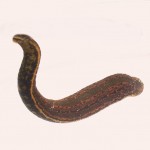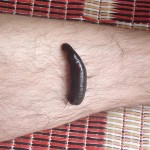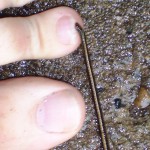 For many of us, the family camping trip also means swimming in open waters. Open waters being lakes, rivers, creeks, ponds, or even the ocean. That also means that you and your family may be exposed to those blood sucking aquatic terrors – leeches.
For many of us, the family camping trip also means swimming in open waters. Open waters being lakes, rivers, creeks, ponds, or even the ocean. That also means that you and your family may be exposed to those blood sucking aquatic terrors – leeches.
Pictured throughout this article, leeches are those slimy worm-like creatures that you find attached to you as you emerge from your favorite swimming hole. They attach to you with their suction cup mouth, and sink their tiny little teeth into you, so that they can fill up on your blood (kinda like a mosquito, only under water).
As a child I was terrified of finding a leech attached to me.
Leeches look a lot like worms with suckers on each end. They can range in size from 1/2 inch to 10 inches (1 cm to 25 cm) and are generally black or brown in color.
 Leeches can be found in just about any body of water and they can find you by detecting skin oils, blood, heat, or the carbon dioxide you breathe out.
Leeches can be found in just about any body of water and they can find you by detecting skin oils, blood, heat, or the carbon dioxide you breathe out.
There is some good news about leeches though. Not all species can bite. Only about 10% of leeches are capable of biting, the other 90% solely feed off decomposing sea life or open wounds (they will feed from a human’s open wound though).
The best way to avoid a leech bite is to cover exposed skin. Good luck convincing your little ones to do that though.
Removal Advice
Never pull a leech off after it has attached to you or your children. This can cause further tearing to the skin, or regurgitation (see below). Instead, use a fingernail or a flat, blunt object to gently break the seal around it’s mouth at the smaller, thinner end. As the seal breaks, the leech will detach.
Alternately, you can leave the leech attached. After about 20 minutes, the leech will become full and detach on it’s own.
Top 9 Ways Not to Remove a Leech
When I was a kid, my parents would tell me about all the great ways that they removed leeches when they were kids. I’ve listed the top 5 below, but I have some bad news for my parents or anyone else who believes in the following techniques – they are not a good idea.
When using these methods they cause the leech to regurgitate it’s stomach contents and quickly detach. That vomit can carry disease and will be directly injected into the wound created by the leech. A study on leeches in Africa found that they can carry both HIV and Hepatitis-B from previous blood sources.
I would encourage you to avoid these methods:
- Salt
- Soap
- Cigarette
- Open Flame
- Alcohol
- Vinegar
- Lemon Juice
- Insect Repellent
- Carbonated Drinks
Top 6 Treatment Tips
- Clean the wound with soap and water.
- If possible, apply a topical first aid treatment such as Bactine or Polysporin.
- Bandage with an appropriate sized bandage.
- Apply pressure to reduce bleeding.
- Anti-histamines (i.e Allegra, Benadryl, etc.) can reduce itching.
- Cold packs or ice packs can reduce swelling and pain.
 Do not scratch the bite as it heals (it will become quite itchy). This can complicate healing or possibly introduce infection.
Do not scratch the bite as it heals (it will become quite itchy). This can complicate healing or possibly introduce infection.
If you develop a reaction to a leech bite such as red blotches, itchy rash over the skin, swelling around the lips or eyes, feeling faint or dizzy, or if you have difficulty breathing then you should consult with a physician immediately.
If you have any leech tips of your own, let us know in the comments.
For more information about leeches, check out the Leech page on Wikipedia.

You must log in to post a comment.